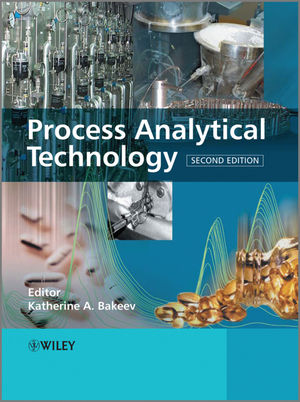Process Analytical Technology: Spectroscopic Tools and Implementation Strategies for the Chemical and Pharmaceutical Industries, 2nd EditionISBN: 978-0-470-72207-7
Hardcover
576 pages
June 2010
 This is a Print-on-Demand title. It will be printed specifically to fill your order. Please allow an additional 10-15 days delivery time. The book is not returnable.
|
||||||
List of Contributors.
List of Abbreviations.
1 Overview of Process Analysis and PAT (Jason E. Dickens).
1.1 Introduction.
1.2 Execution of Process Analysis Projects.
1.3 Process Instrumentation.
1.4 Conclusions.
1.5 Glossary of Acronyms and Terms.
References.
2 Implementation of Process Analytical Technologies (Robert Guenard and Gert Thurau).
2.1 Introduction to Implementation of Process Analytical Technologies (PAT) in the Industrial Setting.
2.2 Generalized Process Analytics Work Process.
2.3 Considerations for PAT Implementation in the Pharmaceutical Industry.
2.4 Conclusions.
References.
3 Process Sampling: Theory of Sampling – the Missing Link in Process Analytical Technologies (PAT) (Kim H. Esbensen and Peter Paasch-Mortensen).
3.1 Introduction.
3.2 Theory of Sampling – Introduction.
3.3 Mass Reduction as a Specific Sampling Procedure.
3.4 Fundamental Sampling Principle.
3.5 Sampling – a Very Practical Issue.
3.6 Reactors and Vessels – Identical Process Sampling Issues.
3.7 Heterogeneity Characterization of 1-D lots: Variography.
3.8 Data Quality – New Insight from the TOS.
3.9 Validation in Chemometrics and PAT.
3.10 Summary.
References.
4 UV-visible Spectroscopy for On-line Analysis (Marcel A. Liauw, Lewis C. Baylor and Patrick E. O’Rourke).
4.1 Introduction.
4.2 Theory.
4.3 Instrumentation.
4.4 Sample Interface.
4.5 Implementation.
4.6 Applications.
4.7 Detailed Application Notes.
4.8 Conclusion.
References.
5 Near-infrared Spectroscopy for Process Analytical Technology: Theory, Technology and Implementation (Michael B. Simpson).
5.1 Introduction.
5.2 Theory of Near-infrared Spectroscopy.
5.3 Analyser Technologies in the Near-infrared.
5.4 The Sampling Interface.
5.5 Practical Examples of Near-infrared Analytical Applications.
5.6 Conclusion.
References.
6 Infrared Spectroscopy for Process Analytical Applications (John P. Coates).
6.1 Introduction.
6.2 Practical Aspects of IR Spectroscopy.
6.3 Instrumentation Design and Technology.
6.4 Process IR Instrumentation.
6.5 Applications of Process IR Analyzers.
6.6 Process IR Analyzers: a Review.
6.7 Trends and Directions.
References.
7 Raman Spectroscopy (Nancy L. Jestel).
7.1 Attractive Features of Raman Spectroscopy.
7.2 Potential Issues with Raman Spectroscopy.
7.3 Fundamentals of Raman Spectroscopy.
7.4 Raman Instrumentation.
7.5 Quantitative Raman.
7.6 Applications.
7.7 Current State of Process Raman Spectroscopy.
References.
8 Near-infrared Chemical Imaging for Product and Process Understanding (E. Neil Lewis, Joseph W. Schoppelrei, Lisa Makein, Linda H. Kidder and Eunah Lee).
8.1 The PAT Initiative.
8.2 The Role of Near-infrared Chemical Imaging (NIR-CI) in the Pharmaceutical Industry.
8.3 Evolution of NIR Imaging Instrumentation.
8.4 Chemical Imaging Principles.
8.5 PAT Applications.
8.6 Processing Case Study: Estimating ‘Abundance’ of Sample Components.
8.7 Processing Case Study: Determining Blend Homogeneity Through Statistical Analysis.
8.8 Final Thoughts.
References.
9 Acoustic Chemometric Monitoring of Industrial Production Processes (Maths Halstensen and Kim H. Esbensen).
9.1 What is Acoustic Chemometrics?
9.2 How Acoustic Chemometrics Works.
9.3 Industrial Production Process Monitoring.
9.4 Available On-line Acoustic Chemometric Equipment.
9.5 Discussion.
9.6 Conclusions.
References.
10 Process NMR Spectroscopy: Technology and On-line Applications (John C. Edwards and Paul J. Giammatteo).
10.1 Introduction.
10.2 NMR Spectroscopy Overview.
10.3 Process NMR Instrumentation.
10.4 Postprocessing Methodologies for NMR Data.
10.5 Advantages and Limitations of NMR as a Process Analytical Technology.
10.6 On-line and At-line Applications.
10.7 Current Development and Applications.
10.8 Conclusions.
References.
11 Fluorescent Sensing and Process Analytical Applications (Jason E. Dickens).
11.1 Introduction.
11.2 Luminescence Fundamentals.
11.3 LIF Sensing Fundamentals.
11.4 LIF Sensing Instrumentation.
11.5 Luminescent Detection Risks.
11.6 Process Analytical Technology Applications.
11.7 Conclusions.
References.
12 Chemometrics in Process Analytical Technology (PAT) (Charles E. Miller).
12.1 Introduction.
12.2 Foundations of Chemometrics.
12.3 Chemometric Methods in PAT.
12.4 Overfitting and Model Validation.
12.5 Outliers.
12.6 Calibration Strategies in PAT.
12.7 Sample and Variable Selection in Chemometrics.
12.8 Troubleshooting/Improving an Existing Method.
12.9 Calibration Transfer and Instrument Standardization.
12.10 Chemometric Model Deployment Issues in PAT.
12.11 People Issues.
12.12 The Final Word.
References.
13 On-line PAT Applications of Spectroscopy in the Pharmaceutical Industry (Brandye Smith-Goettler).
13.1 Background.
13.2 Reaction Monitoring.
13.3 Crystallization.
13.4 API Drying.
13.5 Nanomilling.
13.6 Hot-melt Extrusion.
13.7 Granulation.
13.8 Powder Blending.
13.9 Compression.
13.10 Coating.
13.11 Biologics.
13.12 Cleaning Validation.
13.13 Conclusions.
References.
14 NIR Spectroscopy in Pharmaceutical Analysis: Off-line and At-line PAT Applications (Marcelo Blanco Romía and Manel Alcalá Bernárdez).
14.1 Introduction.
14.2 Foundation of Qualitative Method Development.
14.3 Foundation of Quantitative Method Development.
14.4 Method Validation.
14.5 Calibration Transfer.
14.6 Pharmaceutical Applications.
14.7 Conclusions.
References.
15 Near-infrared Spectroscopy (NIR) as a PAT Tool in the Chemical Industry: Added Value and Implementation Challenges (Ann M. Brearley and Susan J. Foulk).
15.1 Introduction.
15.2 Successful Process Analyzer Implementation.
15.3 Example Applications.
References.
16 Future Trends for PAT for Increased Process Understanding and Growing Applications in Biomanufacturing (Katherine A. Bakeev and Jose C. Menezes).
16.1 Introduction.
16.2 Regulatory Guidance and its Impact on PAT.
16.3 Going Beyond Process Analyzers Towards Solutions.
16.4 Emerging Application Areas of PAT.
16.5 New and Emerging Sensor and Control Technologies.
16.6 Advances in Sampling: NeSSI.
16.7 Challenges Ahead.
16.8 Conclusion.
References.
Index.



